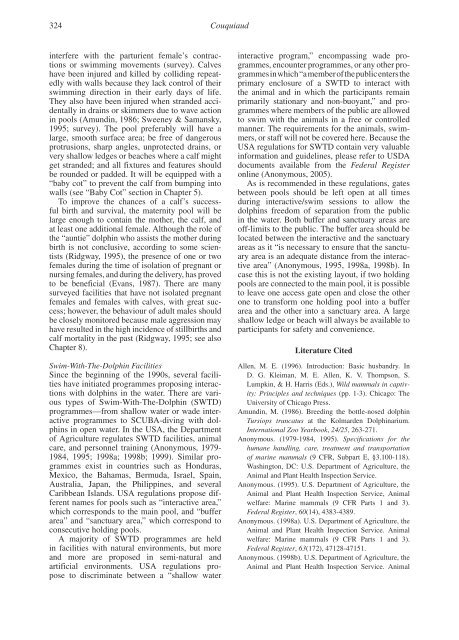Special Issue Survey of Cetaceans in Captive Care
Special Issue Survey of Cetaceans in Captive Care
Special Issue Survey of Cetaceans in Captive Care
Create successful ePaper yourself
Turn your PDF publications into a flip-book with our unique Google optimized e-Paper software.
324 Couquiaud<strong>in</strong>terfere with the parturient female’s contractionsor swimm<strong>in</strong>g movements (survey). Calveshave been <strong>in</strong>jured and killed by collid<strong>in</strong>g repeatedlywith walls because they lack control <strong>of</strong> theirswimm<strong>in</strong>g direction <strong>in</strong> their early days <strong>of</strong> life.They also have been <strong>in</strong>jured when stranded accidentally<strong>in</strong> dra<strong>in</strong>s or skimmers due to wave action<strong>in</strong> pools (Amund<strong>in</strong>, 1986; Sweeney & Samansky,1995; survey). The pool preferably will have alarge, smooth surface area; be free <strong>of</strong> dangerousprotrusions, sharp angles, unprotected dra<strong>in</strong>s, orvery shallow ledges or beaches where a calf mightget stranded; and all fixtures and features shouldbe rounded or padded. It will be equipped with a“baby cot” to prevent the calf from bump<strong>in</strong>g <strong>in</strong>towalls (see “Baby Cot” section <strong>in</strong> Chapter 5).To improve the chances <strong>of</strong> a calf’s successfulbirth and survival, the maternity pool will belarge enough to conta<strong>in</strong> the mother, the calf, andat least one additional female. Although the role <strong>of</strong>the “auntie” dolph<strong>in</strong> who assists the mother dur<strong>in</strong>gbirth is not conclusive, accord<strong>in</strong>g to some scientists(Ridgway, 1995), the presence <strong>of</strong> one or tw<strong>of</strong>emales dur<strong>in</strong>g the time <strong>of</strong> isolation <strong>of</strong> pregnant ornurs<strong>in</strong>g females, and dur<strong>in</strong>g the delivery, has provedto be beneficial (Evans, 1987). There are manysurveyed facilities that have not isolated pregnantfemales and females with calves, with great success;however, the behaviour <strong>of</strong> adult males shouldbe closely monitored because male aggression mayhave resulted <strong>in</strong> the high <strong>in</strong>cidence <strong>of</strong> stillbirths andcalf mortality <strong>in</strong> the past (Ridgway, 1995; see alsoChapter 8).Swim-With-The-Dolph<strong>in</strong> FacilitiesS<strong>in</strong>ce the beg<strong>in</strong>n<strong>in</strong>g <strong>of</strong> the 1990s, several facilitieshave <strong>in</strong>itiated programmes propos<strong>in</strong>g <strong>in</strong>teractionswith dolph<strong>in</strong>s <strong>in</strong> the water. There are varioustypes <strong>of</strong> Swim-With-The-Dolph<strong>in</strong> (SWTD)programmes—from shallow water or wade <strong>in</strong>teractiveprogrammes to SCUBA-div<strong>in</strong>g with dolph<strong>in</strong>s<strong>in</strong> open water. In the USA, the Department<strong>of</strong> Agriculture regulates SWTD facilities, animalcare, and personnel tra<strong>in</strong><strong>in</strong>g (Anonymous, 1979-1984, 1995; 1998a; 1998b; 1999). Similar programmesexist <strong>in</strong> countries such as Honduras,Mexico, the Bahamas, Bermuda, Israel, Spa<strong>in</strong>,Australia, Japan, the Philipp<strong>in</strong>es, and severalCaribbean Islands. USA regulations propose differentnames for pools such as “<strong>in</strong>teractive area,”which corresponds to the ma<strong>in</strong> pool, and “bufferarea” and “sanctuary area,” which correspond toconsecutive hold<strong>in</strong>g pools.A majority <strong>of</strong> SWTD programmes are held<strong>in</strong> facilities with natural environments, but moreand more are proposed <strong>in</strong> semi-natural andartificial environments. USA regulations proposeto discrim<strong>in</strong>ate between a “shallow water<strong>in</strong>teractive program,” encompass<strong>in</strong>g wade programmes,encounter programmes, or any other programmes<strong>in</strong> which “a member <strong>of</strong> the public enters theprimary enclosure <strong>of</strong> a SWTD to <strong>in</strong>teract withthe animal and <strong>in</strong> which the participants rema<strong>in</strong>primarily stationary and non-buoyant,” and programmeswhere members <strong>of</strong> the public are allowedto swim with the animals <strong>in</strong> a free or controlledmanner. The requirements for the animals, swimmers,or staff will not be covered here. Because theUSA regulations for SWTD conta<strong>in</strong> very valuable<strong>in</strong>formation and guidel<strong>in</strong>es, please refer to USDAdocuments available from the Federal Registeronl<strong>in</strong>e (Anonymous, 2005).As is recommended <strong>in</strong> these regulations, gatesbetween pools should be left open at all timesdur<strong>in</strong>g <strong>in</strong>teractive/swim sessions to allow thedolph<strong>in</strong>s freedom <strong>of</strong> separation from the public<strong>in</strong> the water. Both buffer and sanctuary areas are<strong>of</strong>f-limits to the public. The buffer area should belocated between the <strong>in</strong>teractive and the sanctuaryareas as it “is necessary to ensure that the sanctuaryarea is an adequate distance from the <strong>in</strong>teractivearea” (Anonymous, 1995, 1998a, 1998b). Incase this is not the exist<strong>in</strong>g layout, if two hold<strong>in</strong>gpools are connected to the ma<strong>in</strong> pool, it is possibleto leave one access gate open and close the otherone to transform one hold<strong>in</strong>g pool <strong>in</strong>to a bufferarea and the other <strong>in</strong>to a sanctuary area. A largeshallow ledge or beach will always be available toparticipants for safety and convenience.Literature CitedAllen, M. E. (1996). Introduction: Basic husbandry. InD. G. Kleiman, M. E. Allen, K. V. Thompson, S.Lumpk<strong>in</strong>, & H. Harris (Eds.), Wild mammals <strong>in</strong> captivity:Pr<strong>in</strong>ciples and techniques (pp. 1-3). Chicago: TheUniversity <strong>of</strong> Chicago Press.Amund<strong>in</strong>, M. (1986). Breed<strong>in</strong>g the bottle-nosed dolph<strong>in</strong>Tursiops truncatus at the Kolmarden Dolph<strong>in</strong>arium.International Zoo Yearbook, 24/25, 263-271.Anonymous. (1979-1984, 1995). Specifications for thehumane handl<strong>in</strong>g, care, treatment and transportation<strong>of</strong> mar<strong>in</strong>e mammals (9 CFR, Subpart E, §3.100-118).Wash<strong>in</strong>gton, DC: U.S. Department <strong>of</strong> Agriculture, theAnimal and Plant Health Inspection Service.Anonymous. (1995). U.S. Department <strong>of</strong> Agriculture, theAnimal and Plant Health Inspection Service, Animalwelfare: Mar<strong>in</strong>e mammals (9 CFR Parts 1 and 3).Federal Register, 60(14), 4383-4389.Anonymous. (1998a). U.S. Department <strong>of</strong> Agriculture, theAnimal and Plant Health Inspection Service. Animalwelfare: Mar<strong>in</strong>e mammals (9 CFR Parts 1 and 3).Federal Register, 63(172), 47128-47151.Anonymous. (1998b). U.S. Department <strong>of</strong> Agriculture, theAnimal and Plant Health Inspection Service. Animal


